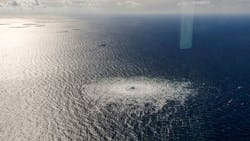Sabotage suspected on leaking Nord Stream pipelines
Offshore staff
STOCKHOLM, Sweden – European countries on Tuesday raced to investigate unexplained leaks in both Nord Stream pipelines running under the Baltic Sea near Sweden and Denmark, according to several online sources. Experts say that the possibility of sabotage cannot be ruled out.
Sweden’s Maritime Authority issued a warning about two leaks in the Nord Stream 1 pipeline, shortly after a leak on the nearby Nord Stream 2 pipeline was discovered that prompted Denmark to restrict shipping in a five nautical mile radius.
A spokesperson for the Swedish Maritime Administration added that both leaks on Nord Stream 1 were in an area northeast of the Danish island Bornholm, one in the Swedish economic zone and another in the Danish zone.
The Danish energy agency warned that vessels could lose buoyancy if they enter the area, and added that there might be a risk of leaked gas igniting over the water and in the air. The officials said that there were no security risks associated with the leak outside the exclusion zone.
As for the cause of the leaks, seismologists in Denmark and Sweden said they had registered two powerful blasts on Monday in the vicinity of the leaks. “The signals do not resemble signals from earthquakes. They do resemble the signals typically recorded from blasts,” the Geological Survey of Denmark and Greenland (GEUS) were reported to have said. And seismologists at Sweden’s Uppsala University, which cooperates with GEUS, said the second, bigger explosion “corresponded to more than 100 kilos (kg) of dynamite,” and added that the blasts were in the water not under the seabed.
Subsequently, officials from Norway, Sweden, and Denmark all said that the damage that caused the leaks appeared to be intentional. Norwegian Minister of Petroleum and Energy Terje Aasland said Tuesday that the initial information received about the leaks indicated “acts of sabotage.”
Swedish Prime Minister Magdalena Andersson and Danish Prime Minister Mette Frederiksen both said that the incident was likely “deliberate” but played down the possibility of a military threat.
German Economy Minister Robert Habeck was quoted as saying that the leaks were due to targeted attacks on the infrastructure. He added that Berlin now knew for sure “that they were not caused by natural occurrences or events or material fatigue.”
Although neither of the Nord Stream pipelines was in operation when the leaks occurred, both lines still contained gas under pressure. Analysts say that the leaks will eliminate any remaining expectations that Europe could receive gas via Nord Stream 1 before winter.
Both pipelines have been flashpoints in an escalating energy war between European capitals and Moscow that has sent natural gas prices soaring and sparked a hunt for alternative energy supplies.
Russia had slashed gas supplies to Europe via Nord Stream 1 before suspending flows altogether in August, blaming Western sanctions for causing technical difficulties. The new Nord Stream 2 pipeline had yet to enter commercial operations. The plan to use it to supply gas was scrapped by Germany days before Russia sent troops into Ukraine in February.
The leaks happened just before the ceremonial launch on Tuesday of the Baltic Pipe carrying gas from Norway to Poland, a centerpiece of Warsaw’s efforts to diversify from Russian supplies.
Norway’s Petroleum Safety Authority had urged oil companies on Monday to be vigilant about unidentified drones seen flying near Norwegian offshore oil and gas platforms, warning of possible attacks.
09.27.2022



